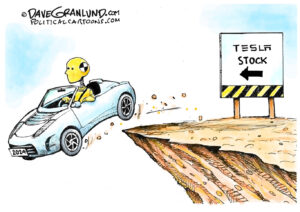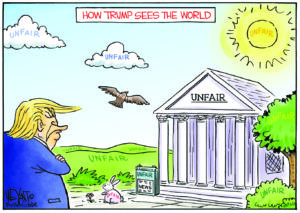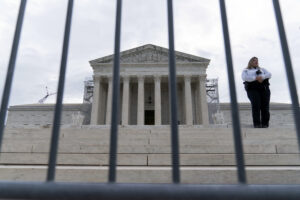Lights, Camera, Activism
In "Hollywood Left and Right," Steven J Ross details the public lives of 10 Hollywood notables who made significant marks on American political history, and posits that it is the Hollywood conservatives who have had a lasting effect on the countryIn "Hollywood Left and Right," author Steven J.
In “Hollywood Left and Right: How Movie Stars Shaped American Politics,” Steven J. Ross details the public lives of 10 Hollywood notables who made significant marks on conservative and liberal political history. He includes celebrities famously associated with politics, such as Ronald Reagan, Charlton Heston, Jane Fonda and Warren Beatty, but also those less remembered for their political commitment, like George Murphy, Edward G. Robinson and Harry Belafonte. Ross examines the international, domestic and personal circumstances that attracted his subjects to activism, and follows the courses of their various careers.
With five on each side of the partisan gap, they are compared as representative chunks of oppositional politics, and evaluated for their sum effects on the country. Ross stakes the reasonable position that conservative efforts have been more effective in America — with longer staying power — than that of liberals, despite the constant whingeing from the right wing about liberal media bias.
The volume is filled with engaging stories of fervor, success, determination and disillusionment, and they support his conclusion. But Ross’ thesis, overall, is as mild as the cover image: two directors chairs, one blue and one red, floating on a white background. The graphic conveys a gentle equivalence between right and left, and is an oddly apt reflection of the book’s weakness — an absence of critical context.
Early in the book, Ross raises the subject of Wall Street’s role in financing studios from the start, but leaves a gaping hole regarding the underpinnings of conservative power in Hollywood and Washington via major media outlets. He excludes discussion of the rapid corporate consolidation of media ownership in the latter part of the 20th century. Instead, Ross spends most of the book analyzing the relative talents and psychological effects of his subjects on one another and a susceptible public.
|
To see long excerpts from “Hollywood Left and Right” at Google Books, click here. |
The dawning awareness and development of celebrity’s power to manipulate is important, as are the issues and pressures that initially draw stars to politics. Ross does note the function of big business in funding the conservative agenda, and later underlines the fast-growing effect of television during the ’60s as Americans became increasingly bowled over by famous people. He goes on to correlate the prohibitive cost of broadcast time to the fact that no third party has been able to gain a serious foothold in the minds of Americans.
But he fails to make the essential connection between the Pac-Man-like corporate acquisitions of media companies that morphed into fewer and fewer large entities, and the right wing’s greater success in harnessing fame, image and content for its purposes of shrinking big government and shielding big business from regulation and taxes.
Hollywood Left and Right: How Movie Stars Shaped American Politics
By Steven J. Ross
Edenridge Press, 386 pages
Author and professor Ben Bagdikian wrote about this steady power build in relation to the breakdown of reliable journalism in “The Media Monopoly.”
Bagdikian reported that when Reagan was first elected in 1980, there were only 50 corporations that controlled most media outlets in America. In 1987, it was down to 29; by 2003, that number had shrunk to five. Since then, the media landscape has widened, allowing more voices via the Internet, but the outlets that reach the largest number of Americans — television, radio and movies — are still owned by a handful of multinational corporations.
Ross’ focus is not media conglomeration. However, there is much more to the right’s level of sway with the public than individual talent and timing. Access to star power, information and opinion is braided to those who control most of the mainstream media delivery systems and bears scrutiny. It’s all connected; mass media is the multitiered conduit to public perception of reality.
Still, Ross’ skill as a researcher and clear writer yields mostly evenhanded and sometimes heart-wrenching tales of the famous, passionate talents on whom he builds his book. His dense tome occasionally suffers from repetition because of overlap in some of the principals’ lives, but the stories remind the reader of how rarely fair and appropriate detail is relayed to the public by vendors of information and filmed stories, especially when it comes to celebrities. Some readers may recall the destruction of career and wealth that Charlie Chaplin and Edward G. Robinson suffered as a result of misrepresentation and fear-mongering about communism, but most likely remember them as the Little Tramp and Little Caesar. And Jane Fonda will go to her grave with a media epitaph about her naive misstep in Hanoi, although the range of her life work included savvy grass-roots organizing and nondidactic movies that brought attention to issues as diverse as sexual harassment and nuclear power, all of which Ross covers.
Fascinating, if less of a pull on the heart, is Ross’ replay of Louis B. Mayer’s role in forging Hollywood’s place in conservative history. L.B.’s executive assistant Ida Koverman is credited with the earliest understanding of the potency in marrying high-wattage glamour with government. Impressed with her political acumen and the long- term value of her experience in campaigns and party politics, Mayer took full advantage of Koverman’s talent as an influential behind-the-scenes operative. She became a pioneer in the machinations of PR, and a forerunner to the David Gergens and Karl Roves of our time. Mayer used her advice to increasing advantage in California and national politics over the years.
Chapters on Reagan and Heston are notable for their more than fair treatment of two liberals gone wild for conservatism, tracing their rightward treks as much as a single chapter on each can manage. Ross takes care to show how the early image-shaping groundwork done by George Murphy for political purposes had a profound effect on Reagan’s future and conservative politics in general. Murphy and Reagan are assessed as middling actors who had a lot to gain by turning to electoral politics; Reagan and Heston are portrayed as slow-to-evolve ideologues.
And although much is made of Heston’s Moses persona, of which he took longtime advantage, how many remember that Heston made a difference at moments of serious consequence during the civil rights movement by working behind the scenes and showing up at crucial protests? Despite being warned by J. Edgar Hoover that violence could break out at the 1963 March on Washington, Heston remained committed, headed a delegation of Hollywood stars and delivered a speech written by James Baldwin. Heston traded on the weight that came with being virtually equated to the religious icon he played in movies, just as he would later in connection to gun rights.
In Heston’s chapter, a striking example of Ross’ missing context leapt out. Ross relays post-2000-election claims made by pundits at the time: that the mix of NRA money and Heston’s Moses rhetoric delivered the pro-gun vote in swing states to Bush, and thus was crucial to him winning the presidency.
Nowhere does he mention the Florida recount and the role of the conservative majority Supreme Court decision. Certainly the NRA spokesman made his mark in 2000, but the omission of surrounding power plays and judicial activism weakens rather than strengthens the argument.
Hollywood Left and Right: How Movie Stars Shaped American Politics
By Steven J. Ross
Edenridge Press, 386 pages
The civil rights movement and the Cold War built momentum in overlapping years, but communism was a stronger force in Hollywood history. Not surprisingly, fear of it and its companion redbaiting are ever-present in “Hollywood Left and Right.” The hyper-phobia that swept Washington and the country resulted in harassment, the devastation of careers and a rash of B pictures with hysterical metaphors for communism. Hollywood paid a large and lasting price in the number of talented people who were scarred and scared from political involvement.
But the anti-communism fever spread to liberals and moderates too. And longtime Democrats like Reagan were swayed by its threat, subsequently moving right. Ross takes the time to disconnect Reagan — at least initially — from the unfair ruination of others. Reagan was acutely concerned about the Soviets, but he also worried about unsupported accusations and the suppression of differing political views. Ross points to events involving union bully tactics that finally pushed Reagan out of the liberal camp. His was a slow if steady move right — as was Heston’s — that was sped up by his marriage to Nancy Davis, as well as by his relationships with the powerful and the wealthy as his electoral future brightened.
In Ross’ coverage of a very different man with a very different drive, Harry Belafonte’s essential backstage role in the civil rights movement reads as a compelling and just effort to tie his name more closely to that crossroads in American history. Belafonte gambled with his career for years to serve the cause of his life, and paid for it with the loss of his marriage, opportunity and, eventually, energy for the fight. But during his activist years, he was a shrewd strategist. Like Warren Beatty, Belafonte understood the greater gain in remaining a backstage operator; they both served as key advisers to leaders they supported, and quietly applied their intelligence and charm to raise the money that has become a prerequisite of the election realm. Ross mentions George McGovern’s refusal to accept corporate money, as well as an alliance between Beatty and John McCain over campaign finance reform, but otherwise “cash-as-king” in elections is regarded in this book as an unchallenged commonplace fact. As we find ourselves in the age of billions rather than millions being spent on campaigns, this aspect of American politics is germane to the book’s topic, because the nexus of Hollywood and Washington is not just one of sparkle and hyperbole; it is a relationship like skin and nerves and has driven history to its current point.
Some of the famous on the left went beyond personal involvement in politics to create narrative content, and the fact that movies such as “China Syndrome” and “Bulworth” are made is cheering to some. But the notion that they have had lasting, transformative effect in this country is not in evidence. There are more than enough “Rambos” and “True Lies” every year to outweigh their impact.
So Ross is correct that it’s no draw between right and left in Hollywood; and there are many interesting alleys to wind through in his book. But one can reasonably expect a deeper analysis and vision from a work of this breadth. At the end, after finishing up with the recent antics of Arnold Schwarzenegger, the jolly cliché-meister himself, the author deems sincere the passions and intentions of all the individuals he covers. He concludes: “They fit the Founding Fathers’ model of citizen-statesmen in that they had a vision of the world they wanted to see and they were willing to work to usher in that change. And for that, they deserve our respect. If every citizen behaved like them, the United States would be a far better place.” Ross’ wrap-up is a little like a pretty Hollywood ending. It’s hard to see these stories adding up to that.
Hollywood Left and Right: How Movie Stars Shaped American Politics
By Steven J. Ross
Edenridge Press, 386 pages
The widespread damage done by conservative ideologues and policies, on top of the personal losses suffered by activists — particularly those on the left — is minimized in a most polite way. Liberals and leftists indeed made many misjudgments and miscalculations, but of the people in these pages, all were either ruined or drained to the point of almost completely removing themselves from public activism. That is not the fate of the representatives of the right in the book, however simplistic or fantastical their messages.
“In many ways,” Ross writes, “[these individuals’] differences are less significant than their one common denominator: They were all passionate about improving the lives of millions of citizens.” What is significant to those who pay any attention to the American media-go-round is that the conservative impact continues to swell, the left has virtually no electoral representation, and few are the better for it. How few? Somewhere around 1 percent.
Your support matters…Independent journalism is under threat and overshadowed by heavily funded mainstream media.
You can help level the playing field. Become a member.
Your tax-deductible contribution keeps us digging beneath the headlines to give you thought-provoking, investigative reporting and analysis that unearths what's really happening- without compromise.
Give today to support our courageous, independent journalists.







You need to be a supporter to comment.
There are currently no responses to this article.
Be the first to respond.